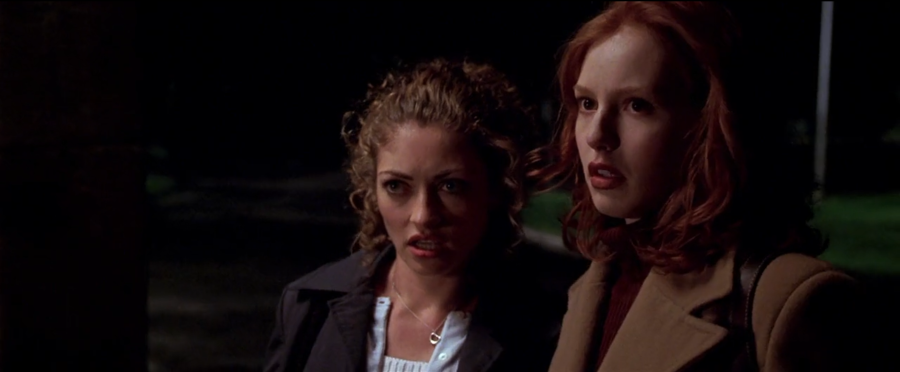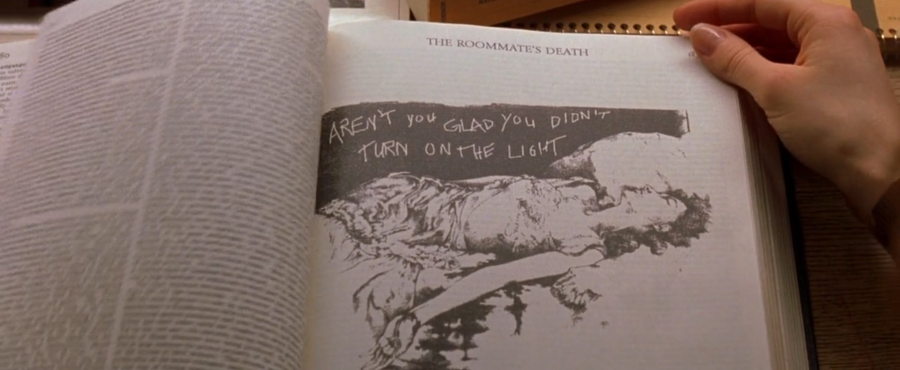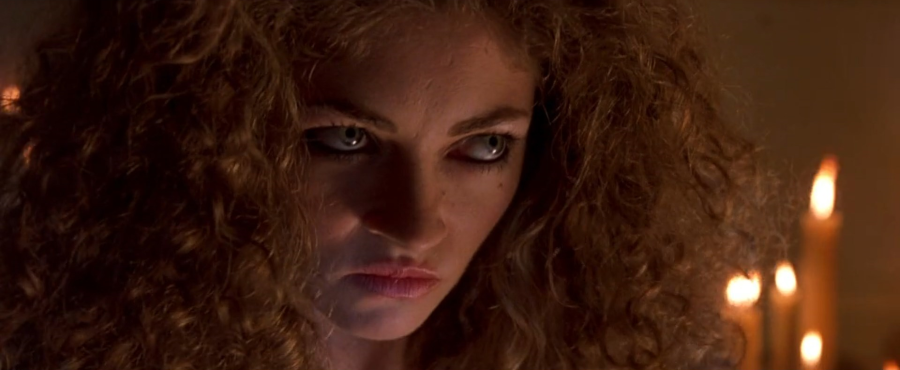URBAN LEGEND
Directed by Jamie Blanks. 1998. United States.

I don’t think it’s possible to discuss a 1990s or early 2000s slasher film without mentioning SCREAM, Wes Craven’s 1996 critical and financial darling. In terms of ripple effects, it was massive, launching not just a wave of self-referential and self-aware horror films, but whole swaths of smarmy teen oriented television shows. SCREAM didn’t just give us I KNOW WHAT YOU DID LAST SUMMER. It gave us JAWBREAKER and Dawson’s Creek. It did for the under 25 audience what PULP FICTION did for everyone else. It gave them an attitude and a vernacular they enjoyed and the Hollywood meat machine started grinding its gears.
Now, I enjoyed SCREAM. Let me get that out of the way right now. I saw the film easily a half dozen times in the theaters. I thoroughly enjoyed seeing a slasher film that had its shit together. It was well crafted, well performed, well paced, bloody, and appropriately cynical. And critics seemed to like it, a rarity for slasher movies not made by John Carpenter. I think that’s because SCREAM, unlike say, PROM NIGHT, has a built-in defense mechanism against the typical critical attacks these movies faced.
SCREAM is a slasher movie that knows it’s a slasher movie. It’s aware of the conventions of the sub-genre, name-dropping like-minded movies left, right, and center during its running time. Pointing out the logical lapses and narrative buffoonery of your average slasher movie is easy. It’s not so easy when the film is one step ahead of you in leveling those criticisms.
So yes, I enjoyed SCREAM at the time but… I will admit that there are more than a few things about the film that rub me the wrong way these days.
For starters, SCREAM is nowhere near as smart as it thinks it is or - just maybe - as it’s pretending to be. I’ve spent my life watching slasher movies so when Randy, the film's stand-in for guys like myself, starts listing off the “rules” for surviving a horror movie, I can see these rules are far from universal. Don’t have sex, don’t drink or do drugs, don’t say “I’ll be right back”... those are not nearly as set in stone as he thinks. Plenty of slasher films feature sexually active party girls as their main character. When Sidney surveys the streets of Woodsboro, awash in police cars following the murder of a high school girl, she remarks that it reminds her of THE TOWN THAT DREADED SUNDOWN. This prompts Dewey to respond “I saw that movie. It’s about a killer in Texas”.
Who is that line of dialogue for? Why does every character drop a movie quote and then immediately tell the person they’re talking to what movie they’re referencing? Wouldn't these horror movie addled teens know already? Why does every character reference horror movie tropes and conventions and never once look around and say “dude… this is totally resembling the form of media we’re all clearly obsessed with”?
In a way, this is meant to set the film up as an authority on slasher films. That way, we don’t question any of the internal logic or narrative twists and turns. But it doesn’t seem to have any greater understanding of the sub-genre than your average soccer mom who once watched HALLOWEEN on the TV back in the 80s while she was babysitting. It got worse in the sequels. SCREAM 2 might be my favorite film in the franchise, but its observation that horror sequels are always bigger and bloodier affairs is about as deep as the thought puddle goes. SCREAM 3 decides it wants to be self-reflexive about commercial exploitation of tragedies and fads, but gets lost in its own pop culture riddled brain, even throwing in a cameo from Jay and Silent Bob to further dilute (and contradict) its own messaging. SCREAM 4 is ostensibly about reboots and remakes but breaks its own subtextual back by never being more than just another sequel.
In hindsight, SCREAM was nowhere near as smart as it seemed to be. It was just overly defensive about its existence. The gags and running commentary about slasher film sexual politics and narrative conveniences is just self-deprecation masquerading as deep insight into a subgenre that doesn’t warrant much insight at all. SCREAM is at its best when it’s simply being a slasher film. It’s at its worst when it’s being a slasher film ABOUT slasher films.

And now that that’s out of the way we can finally talk about Jamie Blank’s 1998 SCREAM clone, URBAN LEGEND, a movie that should have copied what SCREAM did best instead of trying to be another self-referential meta slasher.
Like all SCREAM clones, the characters here are obsessed with one single thing: urban legends. It has infected virtually every single conversation they have. Regardless of what they may be doing at the moment, it seems as though there’s an anecdote to share that somehow ties to a bit of local folklore. It’s tiring and incessant, but it is literally the only string holding this film together.
After watching Natasha Gregson Wagner butcher Bonnie Tyler’s Total Eclipse of the Heart for two solid minutes, we get our first bit of urban legend fuckery. Out of gas, she stops at a gas station. The attendant, conveniently crippled by a major stutter, tries his best to warn her that someone is hiding in her backseat. Thinking he’s trying to assault her, she drives off in the night, only to be decapitated by the backseat butcher, a man or woman possessing the remarkable ability to swing a full-sized ax hard enough from inside a car to lop a head off in one go. That right there is as impressive a feat as you’re going to find in this film.
We meet Natalie, a nondescript redhead whose unfortunate past with Wagner’s Michelle will come to the forefront during the film’s excruciatingly long second act. Along for the ride is college radio host Sasha (conveniently every call she receives at the station is about an urban legend) and her boyfriend Parker, a character so integral to the plot that I had to check IMDB to find out his name for this review. There’s Damon, a frat boy scuzzball with the hots for Natalie, Paul, a college newspaper reporter with the hots for Natalie, and Brenda, a ditzy chick who seemingly has the hots for anyone who has the hots for Natalie.
That is basically our cast right there. Robert Englund plays a college professor teaching all of these kids about - you guessed it - urban legends, the great Loretta Devine plays campus security chief Reese, and John Neville plays the college dean who might as well have been named Larry Vaughn for how often he dismisses murder to keep admissions numbers up. I mention these actors by name as they’re the best things about the film. Guess how much screen time they’re given.

No, we spend all of our time with Natalie as she finds herself at the center of a murder spree. First, her old high school pal Michelle gets her head lopped off. Damon tries making the moves on her in the middle of a field only to be hanged over the car. Her bitchy goth roommate is murdered in the middle of the night while Natalie sleeps on the other side of the room. It’s all very urban legend-y.
Halfway through the film, Natalie convinces Paul that all these deaths are the handiwork of a single serial killer out to add her to their list of victims. We also discover the Traumatic Event that’s powering all of this nonsense. When Natalie and Michelle were in high school, they decided to pull a prank on a teenage boy utilizing - what else? - an urban legend. While driving down a lonely road, they killed their headlights and when the boy flashed them to make them aware of this oversight, they gave chase. The boy lost control of his car, driving off the road and crashing. For their shenanigans that directly lead to someone’s death, Natalie and Michelle were given one year of probation and that was that.
The move from video store obsessed high school kids to college campus lounge abouts necessitated a more academic gimmick. So what we have here are a bunch of dipshits who strangely flex their folklore trivia muscles instead of dipshits who quote horror films but if we’re being honest… it’s really no different. After all, horror films have been stealing from urban legends since the 60s. What is WHEN A STRANGER CALLS but the whole “babysitter gets creepy phone calls” urban legend stretched out to 100 minutes? The Candyman is two urban legends rolled into one with his mirror invocation and hook for a hand. ALLIGATOR has someone flushing a tiny reptile down a Chicago commode. Movies like THE LAST BROADCAST and THE LEGEND OF BOGGY CREEK utilize cryptid legends for their narratives. The killer in THE BURNING is literally named Cropsey, for Christ’s sake. So this really is just another slasher movie about slasher movies only one step removed on the inspiration ladder. If Sidney and her pals read books from time to time, they’d be these people.
The underlying meta stuff is way overplayed and way too prevalent and, even worse, ends up being totally irrelevant in the end. By the time we reach the third act, our killer is just straight up axing people to death. There’s no attempt to work an urban legend into the resolution (outside of the killer’s reveal that it was Natalie and Michelle’s urban legend prank that led to the death of their significant other) so really who cares? It’s just a gimmick.
But like I said before, SCREAM was more than just a gimmick. It was also a satisfying slasher film. How does URBAN LEGEND hold up in those regards?
Past the opening murder set piece (which stars a fantastic Brad Dourif, by the way), not very well. The first five minutes or so of the film are quite well done. Because this is a SCREAM clone, we know better than to get attached to the first character on screen, but Michelle’s skirmish with Dourif and eventual murder are fairly well-executed, even if I still don’t know how someone manages to swing an ax from inside the back of a car with enough force to blahhhh I’m overthinking it.

Unfortunately, the remainder of the film is incredibly lethargic and anemic. It’s also filled with head-scratching scenes and revelations. Why does Robert Englund’s professor have a hidden room in his office? Who built that? Why are there no police officers anywhere in this film? From what I can tell, it’s the head of campus security and the dean of admissions who make the official declarations of whether a death on campus is a murder or a suicide and that’s… well, that’s just not how that works, folks. The final urban legend-inspired murder set piece happens during a party being thrown to commemorate - what else? - a campus urban legend and involves the killer force feeding a man Pop Rocks and drain cleaner. So the killer was just carrying packs of Pop Rocks on them the entire film?
Saying that this film falls apart in its third act is a bit like saying lava is warm. A character is shot point blank by a gun facing away from their body. After momentarily vanquishing the killer, our leads tell a critically injured woman that they’ll get help, only for us to cut to them driving down a country road. The killer’s reveal is accompanied by a damn near eight-minute-long pontification on their motive. To make matters worse, the sequel bait finale reveals the killer to be alive and well on another college campus. I guess because the dean and campus security chief were dead and/or dying before the credits rolled, no one was around to pronounce her dead.
URBAN LEGEND is woefully incompetent. Blanks would fare a bit better a few years down the road with VALENTINE, another SCREAM-inspired slasher but one that knows better than to play the meta card too frequently. VALENTINE contains a single visual reference to an existing horror film, Jack Sholder’s cult classic ALONE IN THE DARK. And you know what? No one calls any attention to it. If Kevin Williamson wrote VALENTINE, he’d never let his characters shut up about it.
URBAN LEGEND on the other hand doesn’t know when to shut up. It keeps calling our attention to its various sources of inspiration, so much so that I began to wonder why. Am I supposed to be impressed? I’m in on the joke within the first ten minutes. Does the film not think I was paying attention? Do I need to keep being told over and over that the killer is using urban legends for their inspiration? Clearly not as Natalie heads to the college library and borrows a big book of urban legends. She browses it with Brenda. She reads it between edits. And what do she and the audience learn from this?
Absolutely nothing.
Remember the movie COPYCAT where the killer was using the MOs of known serial killers and that gives the cops leads enough to catch him? Remember when SEVEN had John Doe using the seven deadly sins for inspiration and then it pays off in the end by making one of the leads into the last remaining sin? Remember when films set things up in their premises and then used those premises to tie everything in a nice thematic bow at the finale? I do.
URBAN LEGEND does not. It’s a gimmick movie where the gimmick masks another routine, by the numbers slasher film that is both bloodless and toothless. The cornball theatrics in the final third gives it some appeal for those who like bad films, but anyone looking for some of that old slasher film magic should just look elsewhere. Might I recommend SCREAM?